进程间通信的理解
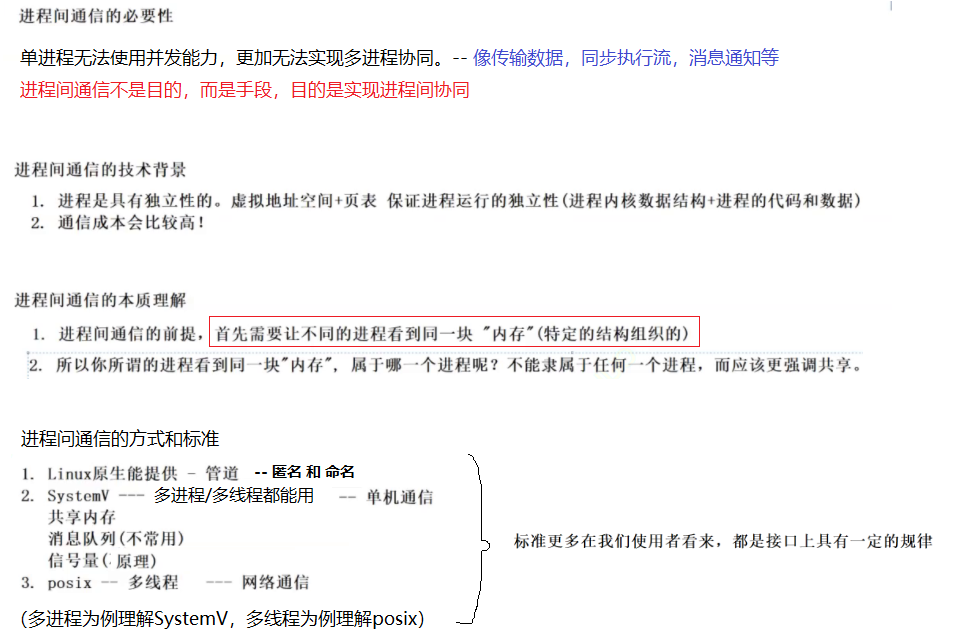
通信本质 - 看到同一份资源
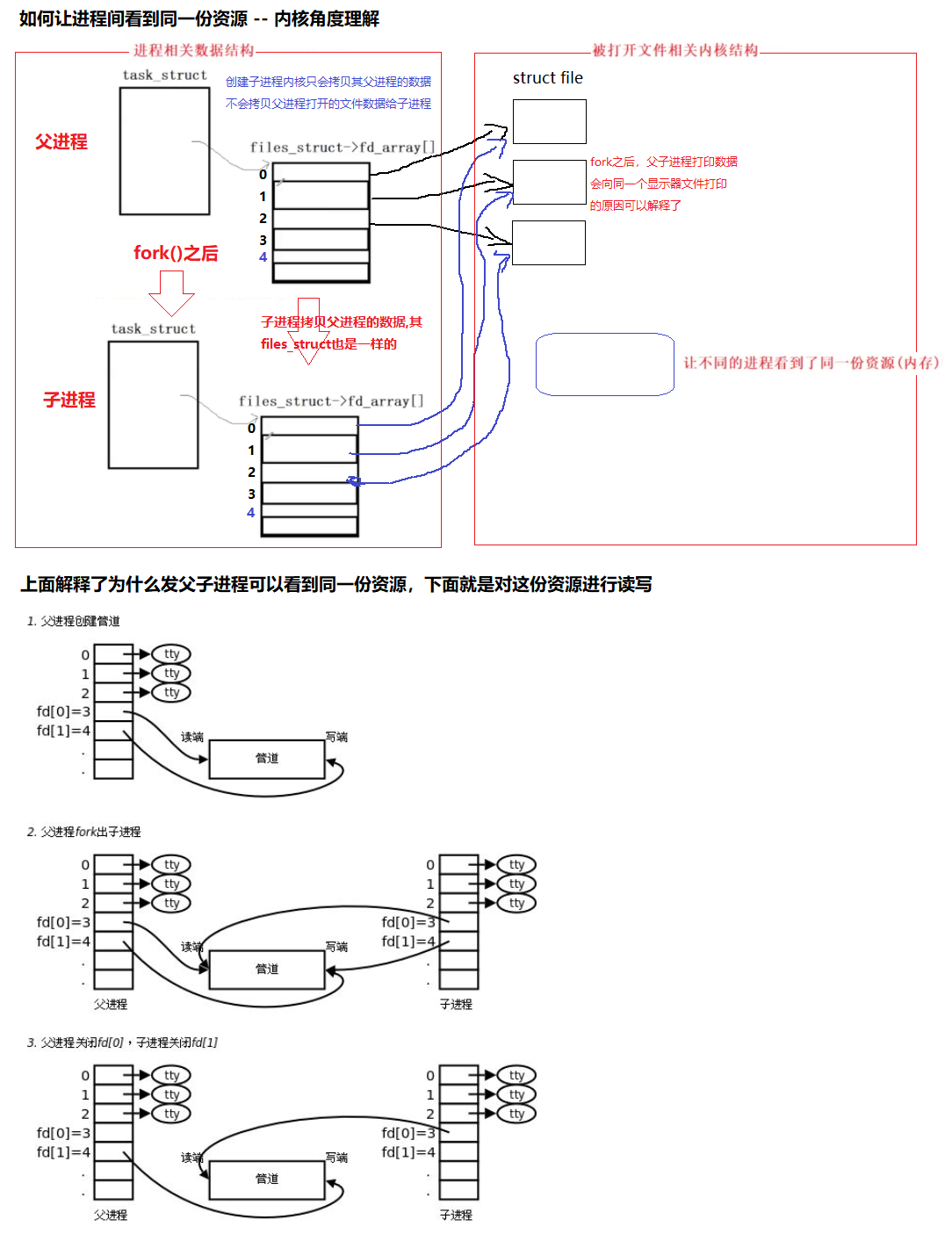
管道通信
什么是管道
- 管道是Unix中最古老的进程间通信的形式。
- 我们把从一个进程连接到另一个进程的一个数据流称为一个“管道”
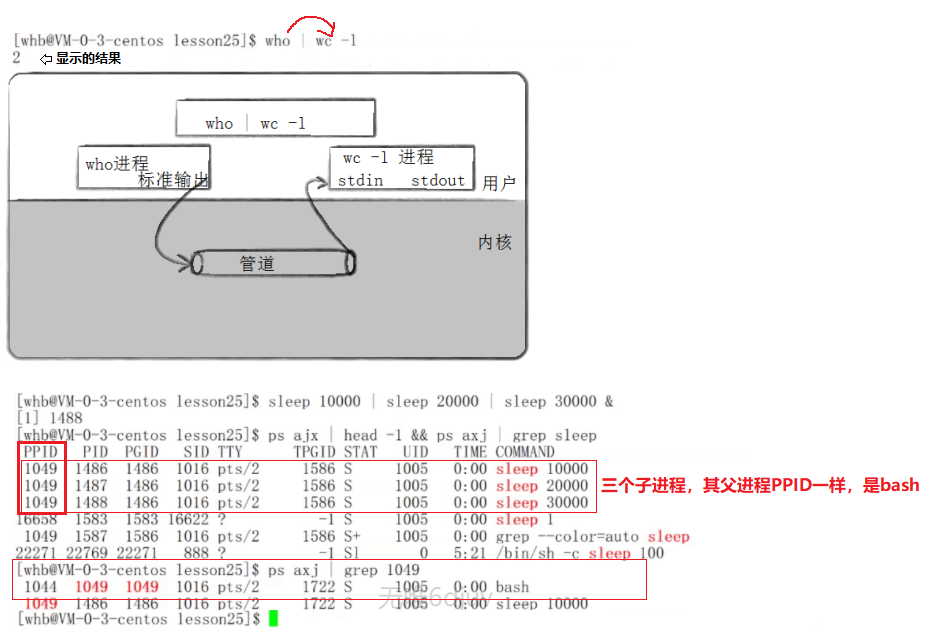
匿名管道
#include <unistd.h>
功能:创建一无名管道
原型
int pipe(int fd[2]);
参数
fd:文件描述符数组,其中fd[0]表示读端, fd[1]表示写端
返回值:成功返回0,失败返回错误代码
匿名管道代码示例
#include <iostream>
#include <string>
#include <cstdio>
#include <cstring>
#include <assert.h>
#include <unistd.h>
#include <sys/types.h>
#include <sys/wait.h>
using namespace std;
// 为什么不定义全局buffer来进行通信呢?? 因为有写时拷贝的存在,无法更改通信!
int main()
{
// 1. 创建管道
int pipefd[2] = {
0}; // pipefd[0(嘴巴,读书)]: 读端 , pipefd[1(钢笔,写)]: 写端
int n = pipe(pipefd);
assert(n != -1); // debug assert, release assert
(void)n;
#ifdef DEBUG
cout << "pipefd[0]: " << pipefd[0] << endl; // 3
cout << "pipefd[1]: " << pipefd[1] << endl; // 4
#endif
// 2. 创建子进程
pid_t id = fork();
assert(id != -1);
if (id == 0)
{
//子进程 - 读
// 3. 构建单向通信的信道,父进程写入,子进程读取
// 3.1 关闭子进程不需要的fd
close(pipefd[1]);
char buffer[1024 * 8];
while (true)
{
// sleep(20);
// 写入的一方,fd没有关闭,如果有数据,就读,没有数据就等
// 写入的一方,fd关闭, 读取的一方,read会返回0,表示读到了文件的结尾!
ssize_t s = read(pipefd[0], buffer, sizeof(buffer) - 1);
if (s > 0)
{
buffer[s] = 0;
cout << "child get a message[" << getpid() << "] Father# " << buffer << endl;
}
else if(s == 0)
{
cout << "writer quit(father), me quit!!!" << endl;
break;
}
}
// close(pipefd[0]);
exit(0);
}
//父进程 - 写
// 3. 构建单向通信的信道
// 3.1 关闭父进程不需要的fd
close(pipefd[0]);
string message = "我是父进程,我正在给你发消息";
int count = 0;
char send_buffer[1024 * 8];
while (true)
{
// 3.2 构建一个变化的字符串
snprintf(send_buffer, sizeof(send_buffer), "%s[%d] : %d",
message.c_str(), getpid(), count++);
// 3.3 写入
write(pipefd[1], send_buffer, strlen(send_buffer));
// 3.4 故意sleep
sleep(1);
cout << count << endl;
if (count == 5){
cout << "writer quit(father)" << endl;
break;
}
}
close(pipefd[1]);
pid_t ret = waitpid(id, nullptr, 0);
cout << "id : " << id << " ret: " << ret <<endl;
assert(ret > 0);
(void)ret;
return 0;
}

管道读写规则
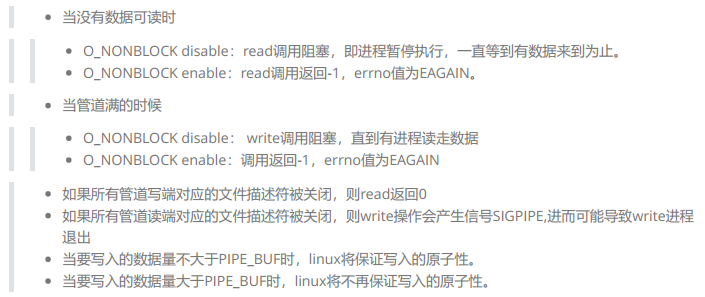
管道特点
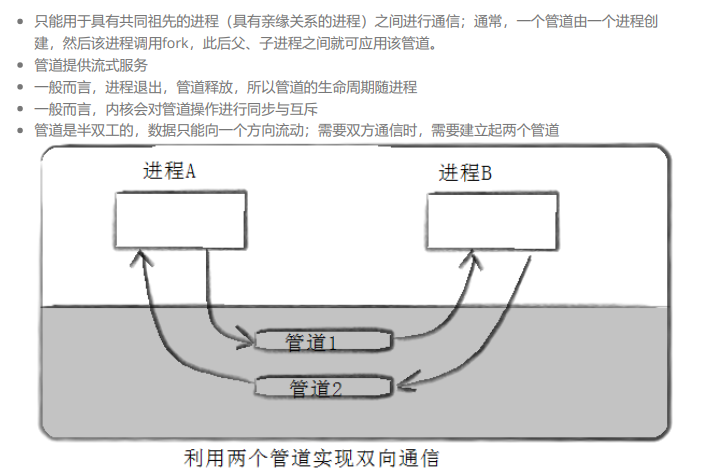
简易内存池
ProcessPool.cc
#include <iostream>
#include <vector>
#include <cstdlib>
#include <ctime>
#include <cassert>
#include <unistd.h>
#include <sys/wait.h>
#include <sys/types.h>
#include "Task.hpp"
#define PROCESS_NUM 5
using namespace std;
int waitCommand(int waitFd, bool &quit) //如果对方不发,我们就阻塞
{
uint32_t command = 0;
ssize_t s = read(waitFd, &command, sizeof(command));
if (s == 0)
{
quit = true;
return -1;
}
assert(s == sizeof(uint32_t));
return command;
}
void sendAndWakeup(pid_t who, int fd, uint32_t command)
{
write(fd, &command, sizeof(command));
cout << "main process: call process " << who << " execute " << desc[command] << " through " << fd << endl;
}
int main()
{
// 代码中关于fd的处理,有一个小问题,不影响我们使用,但是你能找到吗??
load();
// pid: pipefd
vector<pair<pid_t, int>> slots;
// 先创建多个进程
for (int i = 0; i < PROCESS_NUM; i++)
{
// 创建管道
int pipefd[2] = {
0};
int n = pipe(pipefd);
assert(n == 0);
(void)n;
pid_t id = fork();
assert(id != -1);
// 子进程我们让他进行读取
if (id == 0)
{
// 关闭写端
close(pipefd[1]);
// child
while (true)
{
// pipefd[0]
// 等命令
bool quit = false;
int command = waitCommand(pipefd[0], quit); //如果对方不发,我们就阻塞
if (quit)
break;
// 执行对应的命令
if (command >= 0 && command < handlerSize())
{
callbacks[command]();
}
else
{
cout << "非法command: " << command << endl;
}
}
exit(1);
}
// father,进行写入,关闭读端
close(pipefd[0]); // pipefd[1]
slots.push_back(pair<pid_t, int>(id, pipefd[1]));
}
// 父进程派发任务
srand((unsigned long)time(nullptr) ^ getpid() ^ 23323123123L); // 让数据源更随机
while (true)
{
// 选择一个任务, 如果任务是从网络里面来的?
int command = rand() % handlerSize();
// 选择一个进程 ,采用随机数的方式,选择进程来完成任务,随机数方式的负载均衡
int choice = rand() % slots.size();
// 把任务给指定的进程
sendAndWakeup(slots[choice].first, slots[choice].second, command);
sleep(1);
// int select;
// int command;
// cout << "############################################" << endl;
// cout << "# 1. show funcitons 2.send command #" << endl;
// cout << "############################################" << endl;
// cout << "Please Select> ";
// cin >> select;
// if (select == 1)
// showHandler();
// else if (select == 2)
// {
// cout << "Enter Your Command> ";
// // 选择任务
// cin >> command;
// // 选择进程
// int choice = rand() % slots.size();
// // 把任务给指定的进程
// sendAndWakeup(slots[choice].first, slots[choice].second, command);
// }
// else
// {
// }
}
// 关闭fd, 所有的子进程都会退出
for (const auto &slot : slots)
{
close(slot.second);
}
// 回收所有的子进程信息
for (const auto &slot : slots)
{
waitpid(slot.first, nullptr, 0);
}
}
Task.hpp
#pragma once
#include <iostream>
#include <string>
#include <vector>
#include <unordered_map>
#include <unistd.h>
#include <functional>
typedef std::function<void()> func;
std::vector<func> callbacks;
std::unordered_map<int, std::string> desc;
void readMySQL()
{
std::cout << "sub process[" << getpid() << " ] 执行访问数据库的任务\n" << std::endl;
}
void execuleUrl()
{
std::cout << "sub process[" << getpid() << " ] 执行url解析\n" << std::endl;
}
void cal()
{
std::cout << "sub process[" << getpid() << " ] 执行加密任务\n" << std::endl;
}
void save()
{
std::cout << "sub process[" << getpid() << " ] 执行数据持久化任务\n" << std::endl;
}
void load()
{
desc.insert({
callbacks.size(), "readMySQL: 读取数据库"});
callbacks.push_back(readMySQL);
desc.insert({
callbacks.size(), "execuleUrl: 进行url解析"});
callbacks.push_back(execuleUrl);
desc.insert({
callbacks.size(), "cal: 进行加密计算"});
callbacks.push_back(cal);
desc.insert({
callbacks.size(), "save: 进行数据的文件保存"});
callbacks.push_back(save);
}
void showHandler()
{
for(const auto &iter : desc )
{
std::cout << iter.first << "\t" << iter.second << std::endl;
}
}
int handlerSize()
{
return callbacks.size();
}
Makefile
ProcessPool:ProcessPool.cc
g++ -o $@ $^ -std=c++11 #-DDEBUG
.PHONY:clean
clean:
rm -f ProcessPool
命名管道
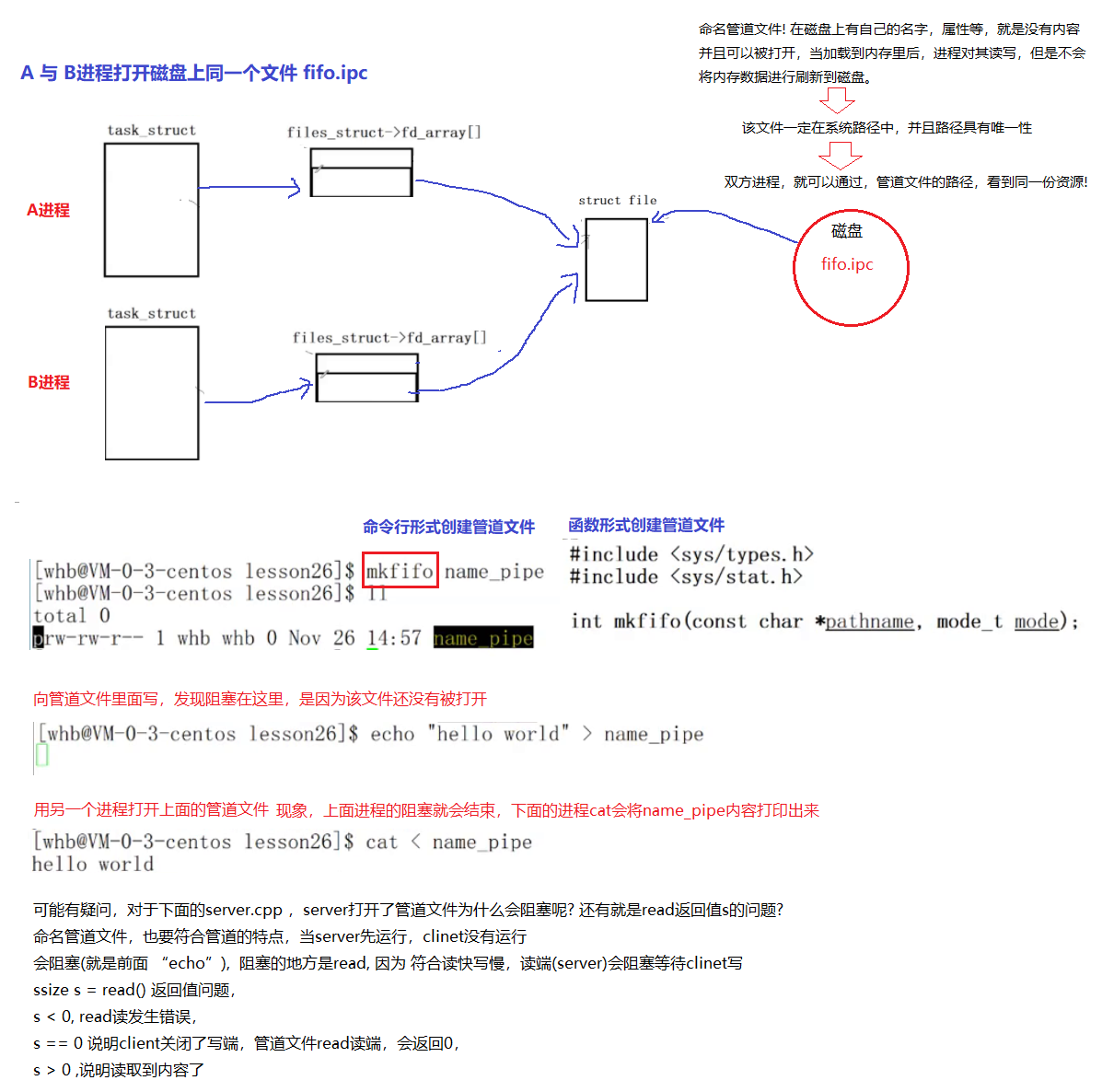
命名管道小代码示例
server.cxx
#include "comm.hpp"
#include <sys/wait.h>
static void getMessage(int fd)
{
char buffer[SIZE];
while (true)
{
memset(buffer, '\0', sizeof(buffer));
ssize_t s = read(fd, buffer, sizeof(buffer) - 1);
if (s > 0)
{
cout <<"[" << getpid() << "] "<< "client say> " << buffer << endl;
}
else if (s == 0)
{
// end of file
cerr <<"[" << getpid() << "] " << "read end of file, clien quit, server quit too!" << endl;
break;
}
else
{
// read error
perror("read");
break;
}
}
}
int main()
{
// 1. 创建管道文件
if (mkfifo(ipcPath.c_str(), MODE) < 0)
{
perror("mkfifo");
exit(1);
}
Log("创建管道文件成功", Debug) << " step 1" << endl;
// 2. 正常的文件操作
(两个进程先运行server,发现阻塞,阻塞的地方是read)
int fd = open(ipcPath.c_str(), O_RDONLY);
if (fd < 0)
{
perror("open");
exit(2);
}
Log("打开管道文件成功", Debug) << " step 2" << endl;
int nums = 3;
for (int i = 0; i < nums; i++)
{
pid_t id = fork();
if (id == 0)
{
// 3. 编写正常的通信代码了
getMessage(fd);
exit(1);
}
}
for(int i = 0; i < nums; i++)
{
waitpid(-1, nullptr, 0);
}
// 4. 关闭文件
close(fd);
Log("关闭管道文件成功", Debug) << " step 3" << endl;
unlink(ipcPath.c_str()); // 通信完毕,就删除文件
Log("删除管道文件成功", Debug) << " step 4" << endl;
return 0;
}
client.cxx
#include "comm.hpp"
int main()
{
// 1. 获取管道文件
int fd = open(ipcPath.c_str(), O_WRONLY);
if(fd < 0)
{
perror("open");
exit(1);
}
// 2. ipc过程
string buffer;
while(true)
{
cout << "Please Enter Message Line :> ";
std::getline(std::cin, buffer);
write(fd, buffer.c_str(), buffer.size());
}
// 3. 关闭
close(fd);
return 0;
}
comm.hpp
#ifndef _COMM_H_
#define _COMM_H_
#include <iostream>
#include <string>
#include <cstdio>
#include <cstring>
#include <unistd.h>
#include <sys/types.h>
#include <sys/stat.h>
#include <fcntl.h>
#include "Log.hpp"
using namespace std;
#define MODE 0666
#define SIZE 128
string ipcPath = "./fifo.ipc";
#endif
Log.hpp
#ifndef _LOG_H_
#define _LOG_H_
#include <iostream>
#include <ctime>
#define Debug 0
#define Notice 1
#define Warning 2
#define Error 3
const std::string msg[] = {
"Debug",
"Notice",
"Warning",
"Error"
};
std::ostream &Log(std::string message, int level)
{
std::cout << " | " << (unsigned)time(nullptr) << " | " << msg[level] << " | " << message;
return std::cout;
}
#endif
Makefile
.PHONY:all
all:client mutiServer
client:client.cxx
g++ -o $@ $^ -std=c++11
mutiServer:server.cxx
g++ -o $@ $^ -std=c++11
.PHONY:clean
clean:
rm -f client mutiServer
system V共享内存
共享内存区是最快的IPC形式。一旦这样的内存映射到共享它的进程的地址空间,这些进程间数据传递不再涉及到内核,换句话说是进程不再通过执行进入内核的系统调用来传递彼此的数据
共享内存示意图
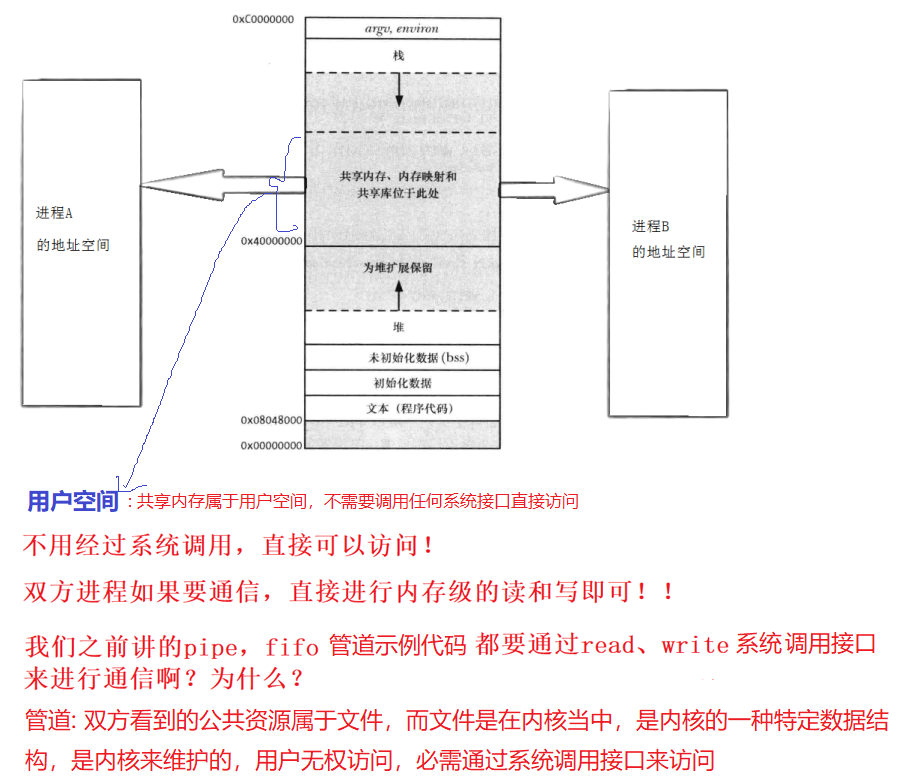
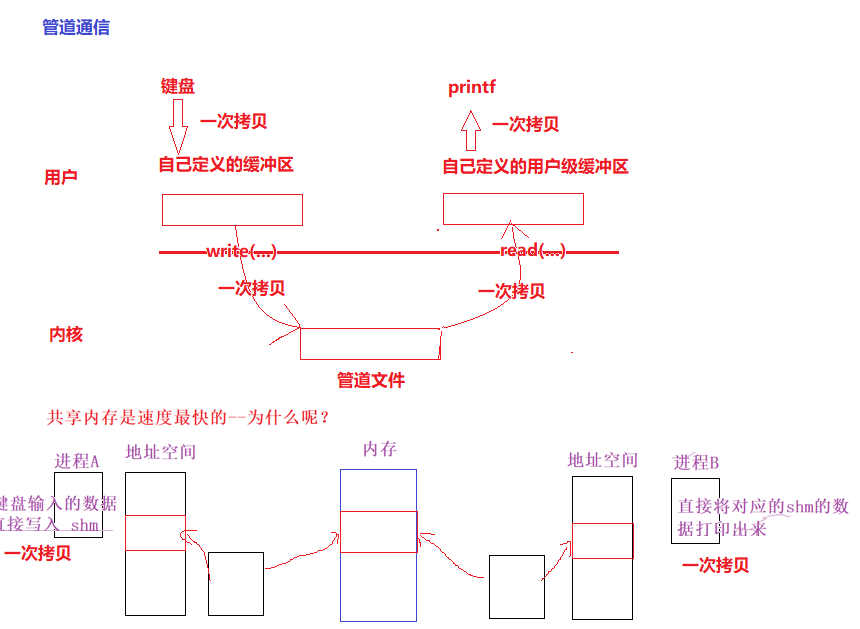
共享内存数据结构

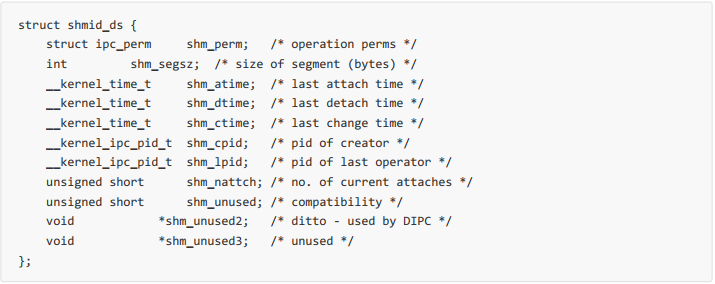
共享内存函数
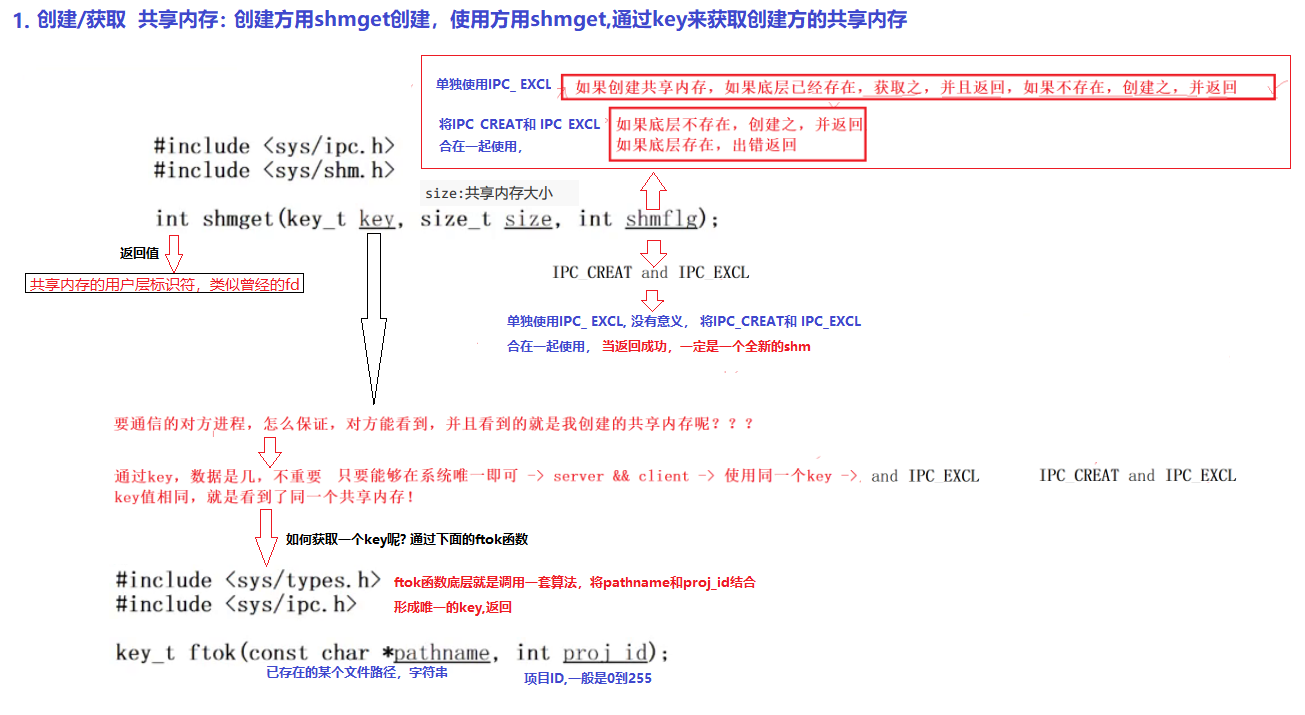
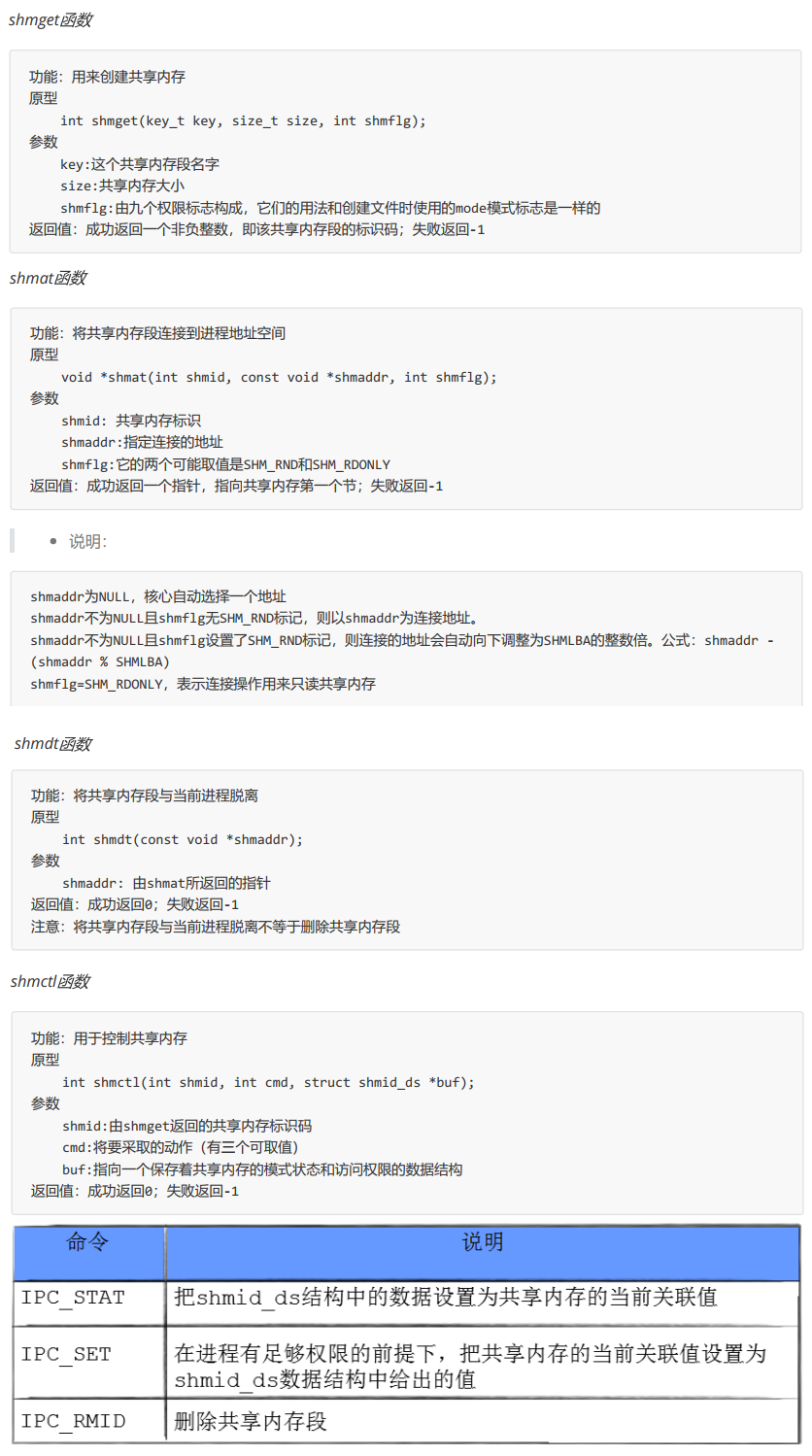

共享内存示例代码
shmServer.cc
#include "comm.hpp"
string TransToHex(key_t k)
{
char buffer[32];
snprintf(buffer, sizeof buffer, "0x%x", k);
return buffer;
}
int main()
{
// 1. 创建公共的Key值
key_t k = ftok(PATH_NAME, PROJ_ID);
assert(k != -1);
Log("create key done", Debug) << " server key : " << TransToHex(k) << endl;
// 2. 创建共享内存 -- 建议要创建一个全新的共享内存 -- 通信的发起者
int shmid = shmget(k, SHM_SIZE, IPC_CREAT | IPC_EXCL | 0666); //
if (shmid == -1)
{
perror("shmget");
exit(1);
}
Log("create shm done", Debug) << " shmid : " << shmid << endl;
sleep(10);
// 3. 将指定的共享内存,挂接到自己的地址空间
char *shmaddr = (char *)shmat(shmid, nullptr, 0);
Log("attach shm done", Debug) << " shmid : " << shmid << endl;
sleep(10);
// 这里就是通信的逻辑了
// 4. 将指定的共享内存,从自己的地址空间中去关联
int n = shmdt(shmaddr);
assert(n != -1);
(void)n;
Log("detach shm done", Debug) << " shmid : " << shmid << endl;
sleep(10);
// 5. 删除共享内存,IPC_RMID即便是有进程和当下的shm挂接,依旧删除共享内存
n = shmctl(shmid, IPC_RMID, nullptr);
assert(n != -1);
(void)n;
Log("delete shm done", Debug) << " shmid : " << shmid << endl;
return 0;
}
共享内存+管道(共享内存缺乏访问控制!可以使用管道来控制)
#include "comm.hpp"
// 是不是对应的程序,在加载的时候,会自动构建全局变量,就要调用该类的构造函数 -- 创建管道文件
// 程序退出的时候,全局变量会被析构,自动调用析构函数,会自动删除管道文件
Init init;
string TransToHex(key_t k)
{
char buffer[32];
snprintf(buffer, sizeof buffer, "0x%x", k);
return buffer;
}
int main()
{
// 我们之前为了通信,所做的所有的工作,属于什么工作呢:让不同的进程看到了同一份资源(内存)
// 1. 创建公共的Key值
key_t k = ftok(PATH_NAME, PROJ_ID);
assert(k != -1);
Log("create key done", Debug) << " server key : " << TransToHex(k) << endl;
// 2. 创建共享内存 -- 建议要创建一个全新的共享内存 -- 通信的发起者
int shmid = shmget(k, SHM_SIZE, IPC_CREAT | IPC_EXCL | 0666); //
if (shmid == -1)
{
perror("shmget");
exit(1);
}
Log("create shm done", Debug) << " shmid : " << shmid << endl;
// sleep(10);
// 3. 将指定的共享内存,挂接到自己的地址空间
char *shmaddr = (char *)shmat(shmid, nullptr, 0);
Log("attach shm done", Debug) << " shmid : " << shmid << endl;
// sleep(10);
// 这里就是通信的逻辑了
// 将共享内存当成一个大字符串
// char buffer[SHM_SIZE];
// 结论1: 只要是通信双方使用shm,一方直接向共享内存中写入数据,另一方,就可以立马看到对方写入的数据。
// 共享内存是所有进程间通信(IPC),速度最快的!不需要过多的拷贝!!(不需要将数据给操作系统)
// 结论2: 共享内存缺乏访问控制!会带来并发问题 【如果我想一定程度的访问控制呢? 能】
int fd = OpenFIFO(FIFO_NAME, READ);
for(;;)
{
Wait(fd);
// 临界区
printf("%s\n", shmaddr);
if(strcmp(shmaddr, "quit") == 0) break;
// sleep(1);
}
// 4. 将指定的共享内存,从自己的地址空间中去关联
int n = shmdt(shmaddr);
assert(n != -1);
(void)n;
Log("detach shm done", Debug) << " shmid : " << shmid << endl;
// sleep(10);
// 5. 删除共享内存,IPC_RMID即便是有进程和当下的shm挂接,依旧删除共享内存
n = shmctl(shmid, IPC_RMID, nullptr);
assert(n != -1);
(void)n;
Log("delete shm done", Debug) << " shmid : " << shmid << endl;
CloseFifo(fd);
return 0;
}
shmClient.cc
#include "comm.hpp"
int main()
{
key_t k = ftok(PATH_NAME, PROJ_ID);
if (k < 0)
{
Log("create key failed", Error) << " client key : " << k << endl;
exit(1);
}
Log("create key done", Debug) << " client key : " << k << endl;
// 获取共享内存
int shmid = shmget(k, SHM_SIZE, 0);
if(shmid < 0)
{
Log("create shm failed", Error) << " client key : " << k << endl;
exit(2);
}
Log("create shm success", Error) << " client key : " << k << endl;
sleep(10);
char *shmaddr = (char *)shmat(shmid, nullptr, 0);
if(shmaddr == nullptr)
{
Log("attach shm failed", Error) << " client key : " << k << endl;
exit(3);
}
Log("attach shm success", Error) << " client key : " << k << endl;
sleep(10);
//使用
// 去关联
int n = shmdt(shmaddr);
assert(n != -1);
Log("detach shm success", Error) << " client key : " << k << endl;
sleep(10);
// client 要不要chmctl删除呢?不需要!!
return 0;
}
共享内存+管道
#include "comm.hpp"
int main()
{
Log("child pid is : ", Debug) << getpid() << endl;
key_t k = ftok(PATH_NAME, PROJ_ID);
if (k < 0)
{
Log("create key failed", Error) << " client key : " << k << endl;
exit(1);
}
Log("create key done", Debug) << " client key : " << k << endl;
// 获取共享内存
int shmid = shmget(k, SHM_SIZE, 0);
if(shmid < 0)
{
Log("create shm failed", Error) << " client key : " << k << endl;
exit(2);
}
Log("create shm success", Error) << " client key : " << k << endl;
// sleep(10);
char *shmaddr = (char *)shmat(shmid, nullptr, 0);
if(shmaddr == nullptr)
{
Log("attach shm failed", Error) << " client key : " << k << endl;
exit(3);
}
Log("attach shm success", Error) << " client key : " << k << endl;
// sleep(10);
int fd = OpenFIFO(FIFO_NAME, WRITE);
// 使用
// client将共享内存看做一个char 类型的buffer
while(true)
{
ssize_t s = read(0, shmaddr, SHM_SIZE-1);
if(s > 0)
{
shmaddr[s-1] = 0;
Signal(fd);
if(strcmp(shmaddr,"quit") == 0) break;
}
}
CloseFifo(fd);
// char a = 'a';
// for(; a <= 'z'; a++)
// {
// shmaddr[a-'a'] = a;
// // 我们是每一次都向shmaddr[共享内存的起始地址]写入
// // snprintf(shmaddr, SHM_SIZE - 1,\
// // "hello server, 我是其他进程,我的pid: %d, inc: %c\n",\
// // getpid(), a);
// sleep(5);
// }
// strcpy(shmaddr, "quit");
// 去关联
int n = shmdt(shmaddr);
assert(n != -1);
Log("detach shm success", Error) << " client key : " << k << endl;
// sleep(10);
// client 要不要chmctl删除呢?不需要!!
return 0;
}
comm.hpp
#pragma once
#include <iostream>
#include <cstdio>
#include <unistd.h>
#include <sys/types.h>
#include <sys/ipc.h>
#include <sys/shm.h>
#include <cassert>
#include "Log.hpp"
using namespace std; //不推荐
#define PATH_NAME "/home/whb"
#define PROJ_ID 0x66
#define SHM_SIZE 4096 //共享内存的大小,最好是页(PAGE: 4096)的整数倍
共享内存+管道
#pragma once
#include <iostream>
#include <cstdio>
#include <unistd.h>
#include <sys/types.h>
#include <sys/ipc.h>
#include <sys/shm.h>
#include <cassert>
#include <cstring>
#include <sys/types.h>
#include <sys/stat.h>
#include <fcntl.h>
#include "Log.hpp"
using namespace std; //不推荐
#define PATH_NAME "/home/whb"
#define PROJ_ID 0x66
#define SHM_SIZE 4096 //共享内存的大小,最好是页(PAGE: 4096)的整数倍
#define FIFO_NAME "./fifo"
class Init
{
public:
Init()
{
umask(0);
int n = mkfifo(FIFO_NAME, 0666);
assert(n == 0);
(void)n;
Log("create fifo success",Notice) << "\n";
}
~Init()
{
unlink(FIFO_NAME);
Log("remove fifo success",Notice) << "\n";
}
};
#define READ O_RDONLY
#define WRITE O_WRONLY
int OpenFIFO(std::string pathname, int flags)
{
int fd = open(pathname.c_str(), flags);
assert(fd >= 0);
return fd;
}
// server是读取数据,先调用wait阻塞等待
// client是放数据的,放完后调signal唤醒server来读数据
void Wait(int fd)
{
Log("等待中....", Notice) << "\n";
uint32_t temp = 0;
ssize_t s = read(fd, &temp, sizeof(uint32_t));
assert(s == sizeof(uint32_t));
(void)s;
}
void Signal(int fd)
{
uint32_t temp = 1;
ssize_t s = write(fd, &temp, sizeof(uint32_t));
assert(s == sizeof(uint32_t));
(void)s;
Log("唤醒中....", Notice) << "\n";
}
void CloseFifo(int fd)
{
close(fd);
}
Log.hpp
#ifndef _LOG_H_
#define _LOG_H_
#include <iostream>
#include <ctime>
#define Debug 0
#define Notice 1
#define Warning 2
#define Error 3
const std::string msg[] = {
"Debug",
"Notice",
"Warning",
"Error"
};
std::ostream &Log(std::string message, int level)
{
std::cout << " | " << (unsigned)time(nullptr) << " | " << msg[level] << " | " << message;
return std::cout;
}
#endif
命名管道和匿名管道和共享内存的一些概念
-
匿名管道只能用于具有亲缘关系的进程间通信,命名管道可用于同一主机上的任意进程间通信
-
管道的通信本质是通过内核中一块缓冲区(内存)时间数据传输,而命名管道的管道文件只是一个标识符,用于让多个进程能够访问同一块缓冲区
-
管道是半双工通信,是可以选择方向的单向通信
-
命名管道打开特性为,若以只读方式打开文件,则会阻塞,直到管道被以写的方式打开,反之亦然
-
管道的本质是内核中的缓冲区,命名管道文件是缓冲区的标识
-
管道在缓冲区写满后会写阻塞,跟磁盘空间并无关系
-
管道的生命周期随进程,本质是内核中的缓冲区,命名管道文件只是标识,用于让多个进程找到同一块缓冲区,删除后,之前已经打开管道的进程依然可以通信
-
命名管道的本质和匿名管道的本质相同都是内核中的一块缓冲区
-
共享内存的本质就是开辟一块物理内存,让多个进程映射同一块物理内存到自己的地址空间进行访问,实现数据共享的。
-
共享内存的操作是非进程安全的,多个进程同时对共享内存读写是有可能会造成数据的交叉写入或读取,造成数据混乱
-
共享内存的删除操作并非直接删除,而是拒绝后续映射,只有在当前映射链接数为0时,表示没有进程访问了,才会真正被删除
-
共享内存生命周期随内核,只要不删除,就一直存在于内核中,除非重启系统(当然这里指的是非手动操作,可以手动删除)
system V消息队列(了解)
消息队列提供了一个从一个进程向另外一个进程发送一块数据的方法
每个数据块都被认为是有一个类型,接收者进程接收的数据块可以有不同的类型值
特性方面:
IPC资源必须删除,否则不会自动清除,除非重启,所以system V IPC资源的生命周期随内核
system V信号量 (了解简单概念)
